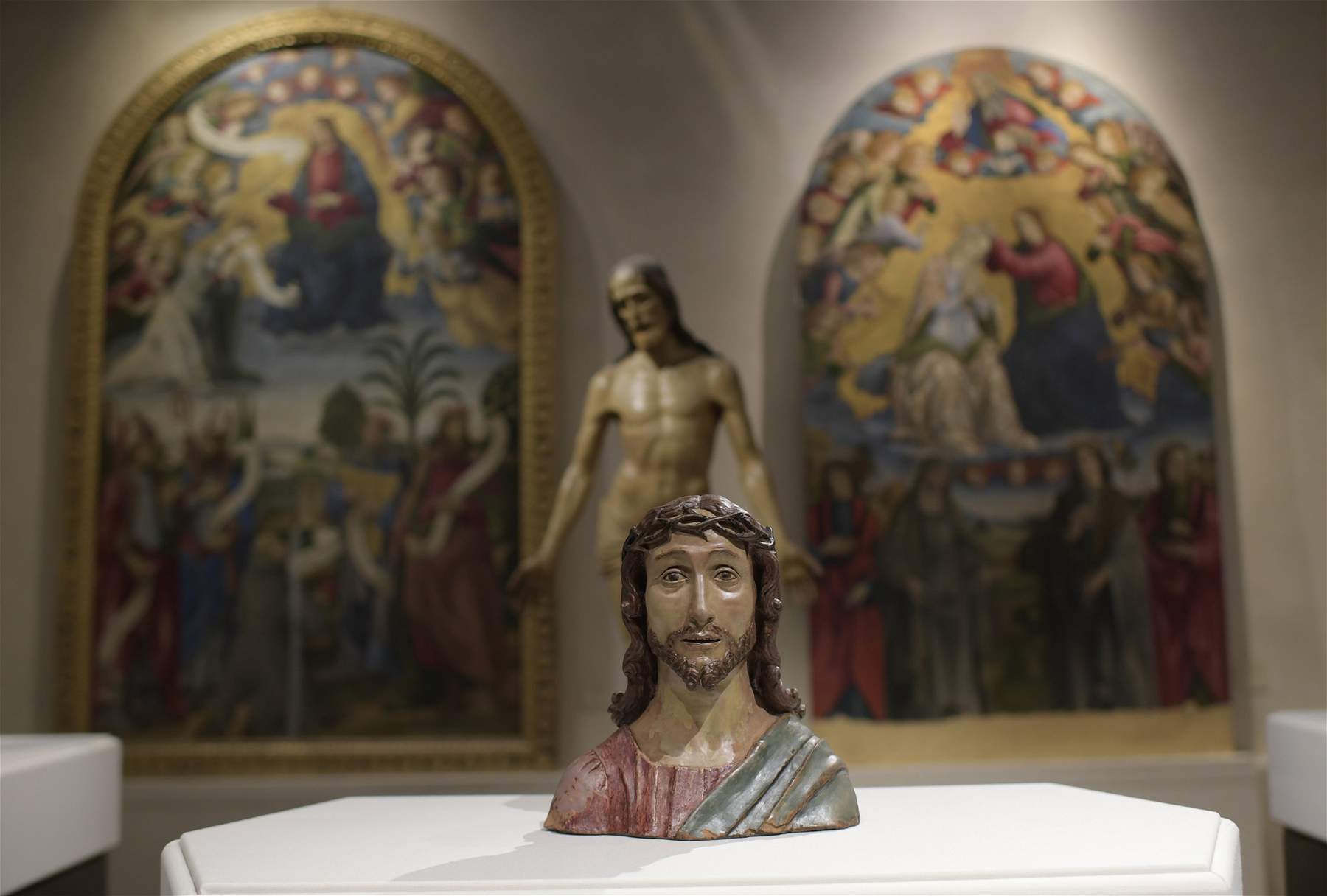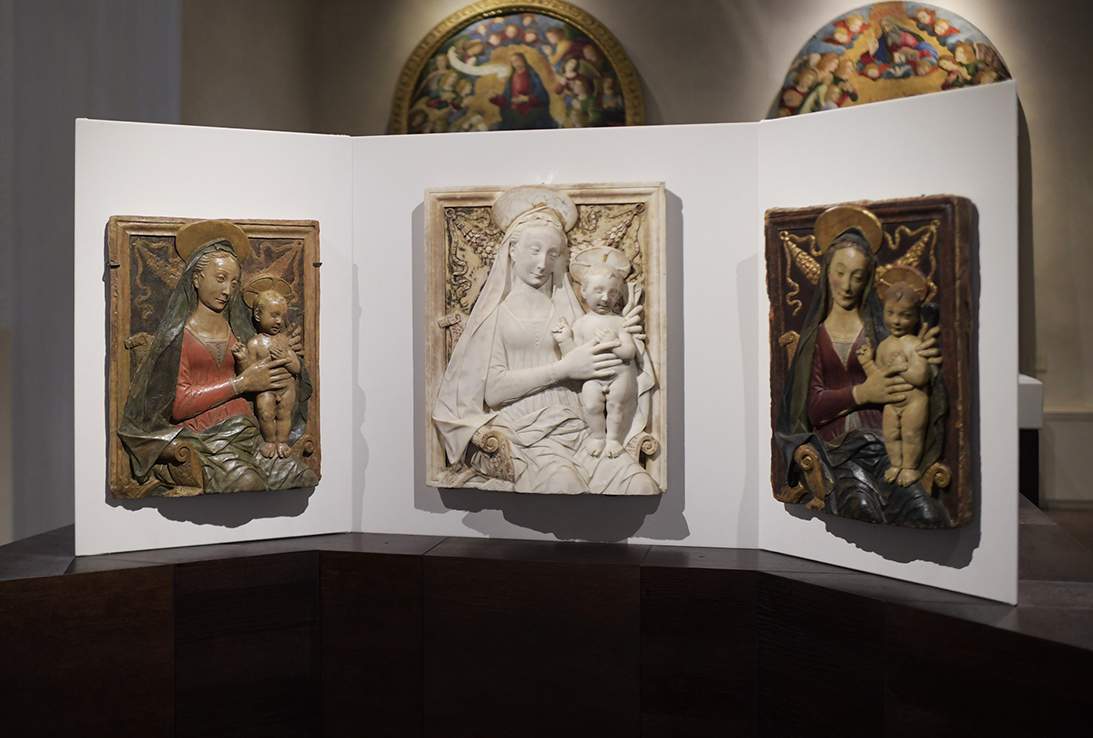From May 14, 2021, and until May 2022, the National Museum of Villa Guinigi in Lucca will exhibit two previously unpublished works by Matteo Civitali (Lucca, 1436 - 1502), discovered by Valentino Anselmi, an official Art Historian in service at the ABAP Superintendence for the Provinces of Lucca and Massa Carrara, as part of a joint project of the Fondazione Banca del Monte di Lucca, which took charge of the restoration and installation, the Soprintendenza Archeologia, Belle Arti e Paesaggio for the provinces of Lucca and Massa Carrara, and the Regional Directorate of Museums of Tuscany, which is hosting the temporary exhibition at the National Museum of Villa Guinigi. The exhibition, entitled New Studies on Matteo Civitali. The Salvator Coronatus from Santa Maria Corteorlandini and the Madonna and Child from Colle di Compito, presents the two new works along with other important works in order to allow useful comparisons.
The first rediscovered work (and this is thanks to ... fingerprints is the Salvator Coronatus, a terracotta sculpture from the church of Santa Maria Corteorlandini that remained unattributed for centuries. The intuition of art historian Anselmi and scientific tests conducted by the RIS of Rome brought out the true identity of the author: Matteo Civitali. In fact, it was the fingerprints found on the work that gave certainty of its “authorship,” laying the groundwork for this exhibition that puts this “rediscovered work” in dialogue with the others by Civitali already in the National Museum on Via della Quarquonia. The second work is a Madonna and Child from a votive shrine in Colle di Compito (hamlet of Capannori).
The path leading to the discovery dates back to early 2018, when Valentino Anselmi, after surveying the church of Santa Maria Corteorlandini in Lucca, visited Vittorio Pascucci’s studio, in which he spotted a sculpture depicting a bust of Christ with a crown of thorns(Salvator Coronatus) that from a distance appeared to be made of bronze. On approaching it he immediately noticed its very high quality and, after feeling and observing it at close range, realized that he was in front of a Renaissance terracotta sculpture by Matteo Civitali that at a time after its execution, probably during the 19th century, would have been patinated to make it resemble one in bronze. The reference to Civitali, Lucca’s most important Renaissance artist, was corroborated by some archival evidence, as it turned out that there were two busts of him in the church of Santa Maria Corteorlandini: one depicting a Christ with the crown of thorns and another representing the Virgin Mary (no longer in the church). Documentary evidence confirms Anselmi’s stylistic analysis, since the terracotta sculpture compares well with the saints executed by Civitali for the ark-altar of San Regolo in the Cathedral of San Martino in Lucca and with two similar subjects, one in marble and another in terracotta, already in the National Museum of Villa Guinigi.
 |
| The Salvator Coronatus |
 |
| The Madonna and Child (center) |
“Preserving, enhancing and making usable that rich heritage made up of artistic and documentary assets of the city/state of Lucca are three precise actions that characterize the mission of the Fondazione Banca del Monte di Lucca in the territory of its competence,” explains Oriano Landucci, president of the Fondazione Banca del Monte di Lucca. “To the truth, to those three actions described above another one should be added, which by its nature and, perhaps, also by its importance precedes the others; it is that of knowing how to find, recognize works of art and artifacts of our history that are all around us. This action is essential so that part of the historical and artistic heritage of our city is not permanently dispersed, but rather returns to bear witness to the true and beautiful of our past.”
“Valentino Anselmi, picked up the sigh of a sleeping work and, recognizing it, reawakened it,” explains Angela Acordon, Soprintendente Archeologia Belle Arti e Paesaggio for the provinces of Lucca and Massa Carrara. “But he was not satisfied, he wanted to know its story and he wanted to tell it to us, working then so that this story would become everyone’s. And so he built, with firm, tenacious and calm patience, the marvelous path that this exhibition tells us about and that sees together at work not only the institutions of the Ministry of Culture: the Regional Museums Directorate of Tuscany, the Soprintendenza Archeologia, Belle Arti e Paesaggio for the provinces of Lucca and Massa Carrara and the Comando dei Carabinieri per la Tutela del Patrimonio Culturale in Florence, but also those of broader and more diverse competence, such as the Carabinieri of the Reparto Investigazioni Scientifiche in Rome, who for once went to search, I think with greater joy, not for the traces of a crime, but for those of an artist. A combination of technical expertise that, thanks to the generous contribution of the Fondazione Banca del Monte di Lucca, the catalyst for the initiative, has enabled the restoration, masterfully executed by the Laboratorio ’Lo Studiolo’ of Lucca, and the exhibition of an important work by Matteo Civitali, the painful and poignant, yet delicate image of a Salvator Coronatus, which Lucca in particular and art history more generally (yet) did not know it had.”
So, the Villa Guinigi National Museum is enriched with two new works by the Lucchese master in the new temporary exhibition with an innovative and sustainable design, conceived by architect Nicola Nottoli and realized by Lucca-based company Allestend. “With particular satisfaction, and consistent with its cultural mission, the National Museum of Villa Guinigi is hosting this exhibition,” stresses Stefano Casciu, Regional Museums Director of Tuscany, “the result of the effective cooperation between public and private institutions that work daily to protect and promote the historical and artistic heritage of this territory. To the Banca del Monte Foundation, to Valentino Anselmi and to Giulia Coco, who in the Regional Museums Directorate of Tuscany follows the museums of Lucca with great commitment, goes my most sincere thanks for this exhibition, whose setting up in the hall of Villa Guinigi dedicated to Matteo Civitali seems particularly opportune to deepen and improve the knowledge of this extraordinary sculptor.”
“The exhibition,” Valentino Anselmi explains, "presents to the public the unpublished Salvator Coronatus of Santa Maria Corteorlandini placed next to two similar subjects, owned by the Fondazione Cassa di Risparmio di Lucca but exhibited at the Villa Guinigi National Museum. To understand the Flemish origin of their iconography in the specially created exhibition itinerary, two paintings will be placed next to the three busts: a Salvator Coronatus by Hans Memling (from Genoa, Musei di Strada Nuova, Palazzo Bianco) and a Mater Dolorosa, which is a copy from Memling, executed by a Florentine artist possibly from Perugino’s circle (from Florence, Uffizi Gallery), as well as a reproduction of Beato Angelico’s Bust of Christ with the Crown of Thorns (original work preserved in Livorno, Museo Civico Giovanni Fattori)."
The presence in the exhibition of the Vir Dolorum in polychrome wood that Matteo Civitali carved in 1487 for the oratory of the disciplined confraternity of San Lorenzo ai Servi in Lucca was considered essential to illustrate the stylistic evolution of the Lucchese master and to highlight the slight differences between the Salvator Coronatus of Santa Maria Corteorlandini and the 1487 Salvator Coronatus, owned by the Fondazione Cassa di Risparmio di Lucca, which certainly reveals more points of contact with the wooden work from the end of the ninth decade of the 15th century. The restoration of the Salvator Coronatus work was handled by Luigi Colombini, Maddalena Lazzareschi and Lucia Ricciarelli’s “Lo Studiolo,” thanks to the contribution of the Fondazione Banca del Monte di Lucca.
The unpublished Madonna and Child from Colle di Compito will be compared with two similar subjects, respectively from the loggia of the Corte dei Mercanti and the church of Sant’Andrea in Pelleria, both in Lucca. Dialoguing with these works will be a terracotta Eucharistic Christ, which shares with the three reliefs the fact that it is stylistically dependent on the figures in Pietro da Noceto’s Funeral Monument, which was made by Civitali for the Cathedral of San Martino between about 1468 and 1472. This also represents the right opportunity to highlight the aforementioned Eucharistic Christ, which was stolen by Nazi troops in February 1944 from the church of Santa Maria della Rosa and was fortunately recovered at the end of 2017 by the Nucleo Tutela Patrimonio Culturale of the Carabinieri of Florence as part of a judicial investigation conducted by the Public Prosecutor’s Office of Lucca, and is now preserved at the National Museum of Villa Guinigi in Lucca.
The exhibition is accompanied by a catalog, published by Maria Pacini Fazzi, edited by Valentino Anselmi. Admission to the exhibition: days, opening hours and how to visit Tuesday and Thursday 9 a.m. - 7:30 p.m. (last admission 6 p.m.). Wednesday, noon - 7:30 p.m. (last admission 6 p.m.). May 15 to June 12, 2021 Fridays and Saturdays 9:00 a.m. - 7:30 p.m. (last admission 6:00 p.m.), June 13 noon - 7:30 p.m. (last admission 6:00 p.m.). 1st and 3rd Sundays of the month 9:00 a.m. - 7:30 p.m. (last entry 6:00 p.m.). Closed: Mondays, 2nd, 4th and 5th Sundays of the month, January 1 and December 25. Tickets: full € 4.00 - reduced € 2.00. A maximum of 12 people can enter the Museum at the same time with compulsory telephone reservation at +39 0583 496033, Monday to Friday from 8:30 to 11:30 am. Reservation is also required for guided tours allowed for groups of maximum 6 people including the guide, with earphones, always respecting the safety distance.
 |
| Important discovery in Lucca: two unpublished works by Matteo Civitali. On display at Villa Guinigi |
Warning: the translation into English of the original Italian article was created using automatic tools. We undertake to review all articles, but we do not guarantee the total absence of inaccuracies in the translation due to the program. You can find the original by clicking on the ITA button. If you find any mistake,please contact us.